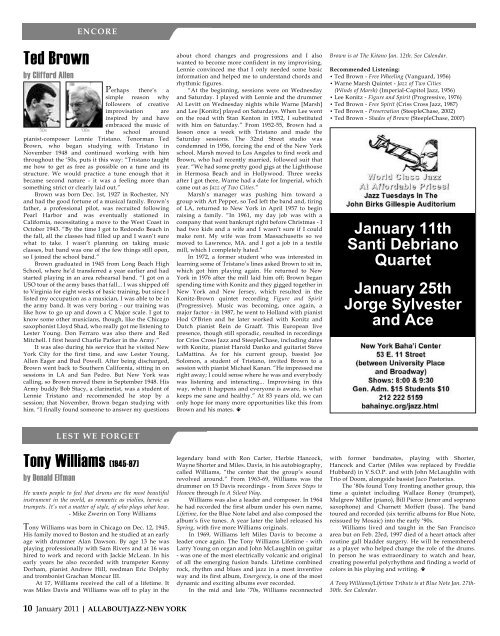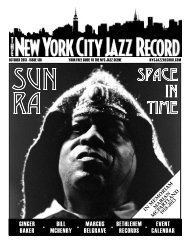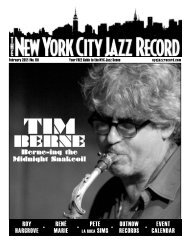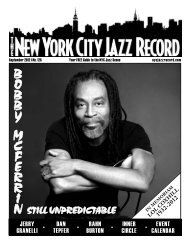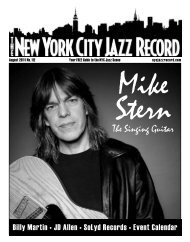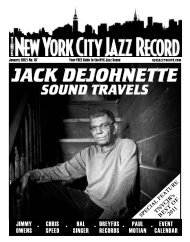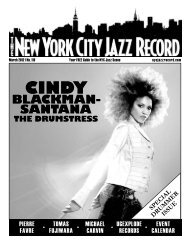heart of gold - The New York City Jazz Record
heart of gold - The New York City Jazz Record
heart of gold - The New York City Jazz Record
Create successful ePaper yourself
Turn your PDF publications into a flip-book with our unique Google optimized e-Paper software.
Ted Brown<br />
by Clifford Allen<br />
ENCORE<br />
Perhaps there’s a<br />
simple reason why<br />
followers <strong>of</strong> creative<br />
improvisation are<br />
inspired by and have<br />
embraced the music <strong>of</strong><br />
‘50s ‘00s the school around<br />
pianist-composer Lennie Tristano. Tenorman Ted<br />
Brown, who began studying with Tristano in<br />
November 1948 and continued working with him<br />
throughout the ‘50s, puts it this way: “Tristano taught<br />
me how to get as free as possible on a tune and its<br />
structure. We would practice a tune enough that it<br />
became second nature - it was a feeling more than<br />
something strict or clearly laid out.”<br />
Brown was born Dec. 1st, 1927 in Rochester, NY<br />
and had the good fortune <strong>of</strong> a musical family. Brown’s<br />
father, a pr<strong>of</strong>essional pilot, was recruited following<br />
Pearl Harbor and was eventually stationed in<br />
California, necessitating a move to the West Coast in<br />
October 1943. “By the time I got to Redondo Beach in<br />
the fall, all the classes had filled up and I wasn’t sure<br />
what to take. I wasn’t planning on taking music<br />
classes, but band was one <strong>of</strong> the few things still open,<br />
so I joined the school band.”<br />
Brown graduated in 1945 from Long Beach High<br />
School, where he’d transferred a year earlier and had<br />
started playing in an area rehearsal band. “I got on a<br />
USO tour <strong>of</strong> the army bases that fall... I was shipped <strong>of</strong>f<br />
to Virginia for eight weeks <strong>of</strong> basic training, but since I<br />
listed my occupation as a musician, I was able to be in<br />
the army band. It was very boring - our training was<br />
like how to go up and down a C Major scale. I got to<br />
know some other musicians, though, like the Chicago<br />
saxophonist Lloyd Shad, who really got me listening to<br />
Lester Young. Don Ferraro was also there and Red<br />
Mitchell. I first heard Charlie Parker in the Army.”<br />
It was also during his service that he visited <strong>New</strong><br />
<strong>York</strong> <strong>City</strong> for the first time, and saw Lester Young,<br />
Allen Eager and Bud Powell. After being discharged,<br />
Brown went back to Southern California, sitting in on<br />
sessions in LA and San Pedro. But <strong>New</strong> <strong>York</strong> was<br />
calling, so Brown moved there in September 1948. His<br />
Army buddy Bob Stacy, a clarinetist, was a student <strong>of</strong><br />
Lennie Tristano and recommended he stop by a<br />
session; that November, Brown began studying with<br />
him. “I finally found someone to answer my questions<br />
LEST WE FORGET<br />
Tony Williams (1945-97)<br />
by Donald Elfman<br />
He wants people to feel that drums are the most beautiful<br />
instrument in the world, as romantic as violins, heroic as<br />
trumpets. It’s not a matter <strong>of</strong> style, <strong>of</strong> who plays what how.<br />
- Mike Zwerin on Tony Williams<br />
Tony Williams was born in Chicago on Dec. 12, 1945.<br />
His family moved to Boston and he studied at an early<br />
age with drummer Alan Dawson. By age 13 he was<br />
playing pr<strong>of</strong>essionally with Sam Rivers and at 16 was<br />
hired to work and record with Jackie McLean. In his<br />
early years he also recorded with trumpeter Kenny<br />
Dorham, pianist Andrew Hill, reedman Eric Dolphy<br />
and trombonist Grachan Moncur III.<br />
At 17, Williams received the call <strong>of</strong> a lifetime. It<br />
was Miles Davis and Williams was <strong>of</strong>f to play in the<br />
10 January 2011 | ALLABOUTJAZZ-NEW YORK<br />
about chord changes and progressions and I also<br />
wanted to become more confident in my improvising.<br />
Lennie convinced me that I only needed some basic<br />
information and helped me to understand chords and<br />
rhythmic figures.<br />
“At the beginning, sessions were on Wednesday<br />
and Saturday. I played with Lennie and the drummer<br />
Al Levitt on Wednesday nights while Warne [Marsh]<br />
and Lee [Konitz] played on Saturdays. When Lee went<br />
on the road with Stan Kenton in 1952, I substituted<br />
with him on Saturday.” From 1952-55, Brown had a<br />
lesson once a week with Tristano and made the<br />
Saturday sessions. <strong>The</strong> 32nd Street studio was<br />
condemned in 1956, forcing the end <strong>of</strong> the <strong>New</strong> <strong>York</strong><br />
school. Marsh moved to Los Angeles to find work and<br />
Brown, who had recently married, followed suit that<br />
year. “We had some pretty good gigs at the Lighthouse<br />
in Hermosa Beach and in Hollywood. Three weeks<br />
after I got there, Warne had a date for Imperial, which<br />
came out as <strong>Jazz</strong> <strong>of</strong> Two Cities.”<br />
Marsh’s manager was pushing him toward a<br />
group with Art Pepper, so Ted left the band and, tiring<br />
<strong>of</strong> LA, returned to <strong>New</strong> <strong>York</strong> in April 1957 to begin<br />
raising a family. “In 1961, my day job was with a<br />
company that went bankrupt right before Christmas - I<br />
had two kids and a wife and I wasn’t sure if I could<br />
make rent. My wife was from Massachusetts so we<br />
moved to Lawrence, MA. and I got a job in a textile<br />
mill, which I completely hated.”<br />
In 1972, a former student who was interested in<br />
learning some <strong>of</strong> Tristano’s lines asked Brown to sit in,<br />
which got him playing again. He returned to <strong>New</strong><br />
<strong>York</strong> in 1976 after the mill laid him <strong>of</strong>f; Brown began<br />
spending time with Konitz and they gigged together in<br />
<strong>New</strong> <strong>York</strong> and <strong>New</strong> Jersey, which resulted in the<br />
Konitz-Brown quintet recording Figure and Spirit<br />
(Progressive). Music was becoming, once again, a<br />
major factor - in 1987, he went to Holland with pianist<br />
Hod O’Brien and he later worked with Konitz and<br />
Dutch pianist Rein de Graaff. This European live<br />
presence, though still sporadic, resulted in recordings<br />
for Criss Cross <strong>Jazz</strong> and SteepleChase, including dates<br />
with Konitz, pianist Harold Danko and guitarist Steve<br />
LaMattina. As for his current group, bassist Joe<br />
Solomon, a student <strong>of</strong> Tristano, invited Brown to a<br />
session with pianist Michael Kanan. “He impressed me<br />
right away; I could sense where he was and everybody<br />
was listening and interacting... Improvising in this<br />
way, when it happens and everyone is aware, is what<br />
keeps me sane and healthy.” At 83 years old, we can<br />
only hope for many more opportunities like this from<br />
Brown and his mates. K<br />
legendary band with Ron Carter, Herbie Hancock,<br />
Wayne Shorter and Miles. Davis, in his autobiography,<br />
called Williams, “the center that the group’s sound<br />
revolved around.” From 1963-69, Williams was the<br />
drummer on 15 Davis recordings - from Seven Steps to<br />
Heaven through In A Silent Way.<br />
Williams was also a leader and composer. In 1964<br />
he had recorded the first album under his own name,<br />
Lifetime, for the Blue Note label and also composed the<br />
album’s five tunes. A year later the label released his<br />
Spring, with five more Williams originals.<br />
In 1969, Williams left Miles Davis to become a<br />
leader once again. <strong>The</strong> Tony Williams Lifetime - with<br />
Larry Young on organ and John McLaughlin on guitar<br />
- was one <strong>of</strong> the most electrically volcanic and original<br />
<strong>of</strong> all the emerging fusion bands. Lifetime combined<br />
rock, rhythm and blues and jazz in a most inventive<br />
way and its first album, Emergency, is one <strong>of</strong> the most<br />
dynamic and exciting albums ever recorded.<br />
In the mid and late ‘70s, Williams reconnected<br />
Brown is at <strong>The</strong> Kitano Jan. 12th. See Calendar.<br />
Recommended Listening:<br />
• Ted Brown - Free Wheeling (Vanguard, 1956)<br />
• Warne Marsh Quintet - <strong>Jazz</strong> <strong>of</strong> Two Cities<br />
(Winds <strong>of</strong> Marsh) (Imperial-Capitol <strong>Jazz</strong>, 1956)<br />
• Lee Konitz - Figure and Spirit (Progressive, 1976)<br />
• Ted Brown - Free Spirit (Criss Cross <strong>Jazz</strong>, 1987)<br />
• Ted Brown - Preservation (SteepleChase, 2002)<br />
• Ted Brown - Shades <strong>of</strong> Brown (SteepleChase, 2007)<br />
January 11th<br />
Santi Debriano<br />
Quartet<br />
January 25th<br />
Jorge Sylvester<br />
and Ace<br />
with former bandmates, playing with Shorter,<br />
Hancock and Carter (Miles was replaced by Freddie<br />
Hubbard) in V.S.O.P. and with John McLaughlin with<br />
Trio <strong>of</strong> Doom, alongside bassist Jaco Pastorius.<br />
<strong>The</strong> ‘80s found Tony fronting another group, this<br />
time a quintet including Wallace Roney (trumpet),<br />
Mulgrew Miller (piano), Bill Pierce (tenor and soprano<br />
saxophone) and Charnett M<strong>of</strong>fett (bass). <strong>The</strong> band<br />
toured and recorded (six terrific albums for Blue Note,<br />
reissued by Mosaic) into the early ‘90s.<br />
Williams lived and taught in the San Francisco<br />
area but on Feb. 23rd, 1997 died <strong>of</strong> a <strong>heart</strong> attack after<br />
routine gall bladder surgery. He will be remembered<br />
as a player who helped change the role <strong>of</strong> the drums.<br />
In person he was extraordinary to watch and hear,<br />
creating powerful polyrhythms and finding a world <strong>of</strong><br />
colors in his playing and writing. K<br />
A Tony Williams/Lifetime Tribute is at Blue Note Jan. 27th-<br />
30th. See Calendar.


